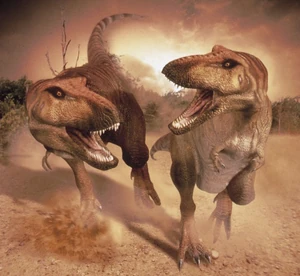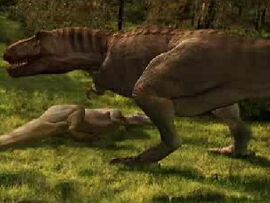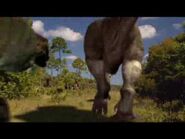
| |
| Creature information | |
| Scientific name : | Tyrannosaurus rex |
| Time period : | Late Cretaceous |
| Primary diet : | Carnivore |
| In the documentary | |
| Fatalities caused : | One Edmontosaurus |
Tyrannosaurus Rex (or T. Rex for short) was a species of large theropod dinosaur that lived during the end of the Late Cretaceous period.
Facts[]
Tyrannosaurus was among the largest terrestrial predators to ever walk the Earth, reaching lengths of up to 13 meters (52 feet) and weighing in excess of 8 tons; few carnivorous dinosaurs matched it in size. Evidence shows that tyrannosaurus often fed on large herbivores such as Edmontosaurus and Triceratops, being the apex predator of its environment. They were likely opportunistic carnivores, both actively hunting live prey and scavenging from already dead animals. It is also believed that they may have at times been cannibalistic, eating others of their own kind.
In most media and film or television subtitles, the dinosaur is often referred to as “T-Rex“ or “T. Rex.“ Michael Crichton, the author of the Jurassic Park novels, referred to it as “Tyrannosaurus Rex”, or “T-Rex” for short in his famous works of literature. Despite its popularity, this spelling is wrong. Dinosaur names are created according to the rules of the binomial nomenclature. Binomial names consist of two parts. Tyrannosaurus is the genus name, while Rex is the species name. Genus names must be written with a capital letter, while the species name is not. In many cases, mostly with the longer names, it is shortened. In such cases, only the first letter of the genus name is written; that letter is then followed by a period, not a "-". All binomial nomenclatural taxon should be written in italics. Therefore then, the taxa should be written like this: Tyrannosaurus Rex, or for short: T. Rex.
When Dinosaurs Roamed America[]

Tyrannosaurus Rex
In the late Cretaceous segment, a juvenile Tyrannosaurus is first seen stalking groups of Edmontosaurus, Ornithomimus and Triceratops. Later, the young T. Rex charges at a herd of Triceratops, but the herd easily fends the inexperienced youngster off; he then attempts to chase down a Quetzalcoatlus feeding on a Triceratops carcass, but the pterosaur escapes. The tyrant prince eventually makes his way home, walking through the forest at night and returning to his family. The pack of tyrannosaurs consists of two adults; a male, and an even larger female whom’s leg has been crippled by a painful injury, along with the juvenile and his sibling. Amidst the playful sparring of the two, they accidentally hit their mother’s wounded leg, prompting her to roar out in pain as the two then flee; shortly after, the tyrants all leave the nest, preparing for tomorrow’s hunt. The next morning, the Tyrannosaurus pack attacks the Edmontosaurus herd; the youngest first gives chase, herding them into a trap as his larger sibling then joins the fray, surprising the three hadrosaurs they’ve separated from the fleeing herd. They manage to force one individual to split from the other two, leading it directly into the jaws of their mother, who ambushes the Edmontosaurus and successfully brings it down with ease followed by a victorious roar. Later in the evening, as the tyrants feed on their kill, the mother looks up into the sky to see an asteroid heading towards the planet. As it strikes the Earth and the world around them is set ablaze, the Tyrannosaurus abandon the Edmontosaurus carcass and flee. Unfortunately, even the Tyrant Lizard King is no match for the destructive power of the asteroid, joining its fellow non-avian dinosaurs in extinction. Finally, as the chaos fades and the dust settles, a group of Purgatorius are seen crawling onto the skull of a T. Rex, signifying the end of the reign of the dinosaurs and a new beginning for Planet Earth,
Scientific Inaccuracies[]
- The female Tyrannosaurus is depicted as being significantly larger than her mate as a result of sexual dimorphism, a theory that is currently unsupported by scientific evidence.
- Contrary to popular belief, it is now likely that Tyrannosaurus Rex was not feathered. It was believed for some time that the dinosaur’s scaled appearance in the documentary was accurate, but recent evidence shows that it is likely correct.
- Tyrannosaurus‘s hands at times appear to facing down, pronated, a common error perpetuated by media such as Jurassic Park and Walking With Dinosaurs. All theropods are believed to have inward-facing hands, often likened to a clapping position; they could not pivot their hands either.
- Recent evidence shows that Tyrannosaurus likely had fleshy, immobile lips that concealed its teeth akin to those of lizards, although this is still a point of debate among paleontologists to this day.
Trivia[]

Mother T. Rex with a dead Edmontosaurus
- As North America's Top Predator, Tyrannosaurus Rex is commonly known as the lion of the Cretaceous.
- It is among the most famous of all the dinosaur clan, known for its strong presence in pop culture alongside similarly popular dinosaurs such as Stegosaurus and Triceratops.
- Its name translates to “Tyrant Lizard King” in Latin, hence its longtime reputation as the fearsome King of the Dinosaurs.
- Stock footage of the Tyrannosaurus from When Dinosaurs Roamed America is used in the original documentary Valley of the T. Rex which itself seemingly had its own T. Rex model retooled for Dinosaur Planet, which also uses the same footage.






